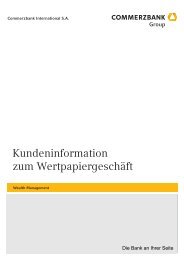Dresdner Bank - Commerzbank International SA
Dresdner Bank - Commerzbank International SA
Dresdner Bank - Commerzbank International SA
You also want an ePaper? Increase the reach of your titles
YUMPU automatically turns print PDFs into web optimized ePapers that Google loves.
<strong>Dresdner</strong> <strong>Bank</strong> Luxembourg S.A. Annual Report 2008<br />
62<br />
D. Risk Management<br />
Risks are a significant component of banking business. The bank’s success crucially depends on systematically<br />
identifying, quantifying and effectively managing the bank-specific credit, market and liquidity<br />
risks (so-called primary risks) consciously entered into within the context of the business activity. Furthermore,<br />
efficient and integrated risk management and risk controlling require the integration of all entrepreneurial<br />
risks, which are also not bank-specific. These include the risk associated with short-term and<br />
long-term business planning and business structure – business risk and strategic risk – as well as the<br />
operational and reputational risks (so-called secondary risks) frequently also occurring interactively with<br />
the primary risks.<br />
The bank generally pursues a conservative and very selective risk strategy with regard to entering into<br />
risks. In doing so, the risk strategy defined by the Management Board and Supervisory Board of <strong>Dresdner</strong><br />
<strong>Bank</strong> AG forms the framework for the local risk strategy of the bank.<br />
With the aim of the clear separation of functions, the bank’s market segments report to one board<br />
member, while a further board member is responsible for risk monitoring and controlling functions. Risk<br />
management is an integral part of the bank’s management and controlling processes. Risks are taken<br />
with consideration to returns and potential losses while risk-bearing capabilities as well as clear responsibilities<br />
are also taken into account. The risk management process includes the identification, analysis,<br />
measurement, monitoring, communication and management of risk. The bank’s management and<br />
relevant <strong>Dresdner</strong> <strong>Bank</strong> Group functions are kept regularly informed of the risk situation through various<br />
reports.<br />
Supervisory Board<br />
(Audit Committee)<br />
Delegation<br />
Management Board<br />
Information<br />
Monitoring / Control<br />
� Risk Management � Compliance<br />
� Finance/Controlling � Legal<br />
� External auditors � Audit<br />
� Approval of rules of procedure<br />
� Approvals of transactions via Management Board competence<br />
� Approval of participating interests<br />
� Approval of limits<br />
� Confirmation of risk profile<br />
� Responsibility for business policy<br />
� Responsibility for credit policy<br />
� Responsibility for equity capital investment/liquidity management<br />
� Defining limits<br />
� Defining risk suitability / risk profile<br />
Risk Management<br />
� Divisions: decentralised within the context of their duties<br />
� Liquidity Management: centralised interest / liquidity / FX<br />
� ALCO: Advising Management Board, asset/liability management,<br />
equity capital investment, strategic risk management<br />
Supervisory<br />
Board<br />
Rules of<br />
procedure<br />
Management<br />
Board<br />
Rules of<br />
procedure






